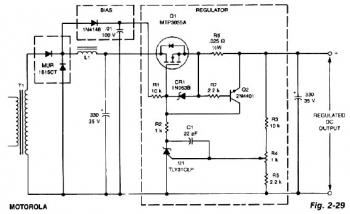The following diagram is the cheap Low-Dropout linear regulator circuit.
This linear post regulator circuit provides 12 V at 3 A. It applies TL431 reference U1 which, without additional amplification, drives TMOS MTP3055A gate Q1 series pass regulator. Bias voltage is applied through R1 to Q1's gate, which is protected against overvoltage by diode CR1. Frequency compensation for closed-loop stability is provided by C1.
Circuit Characteristics:
Dropout voltage: 0.6 V
Line regulation: ±5 mV
Load regulation: 10 mV
Output ripple: 10 mV pk-pk
This linear post regulator circuit provides 12 V at 3 A. It applies TL431 reference U1 which, without additional amplification, drives TMOS MTP3055A gate Q1 series pass regulator. Bias voltage is applied through R1 to Q1's gate, which is protected against overvoltage by diode CR1. Frequency compensation for closed-loop stability is provided by C1.
Circuit Characteristics:
Dropout voltage: 0.6 V
Line regulation: ±5 mV
Load regulation: 10 mV
Output ripple: 10 mV pk-pk

Comments